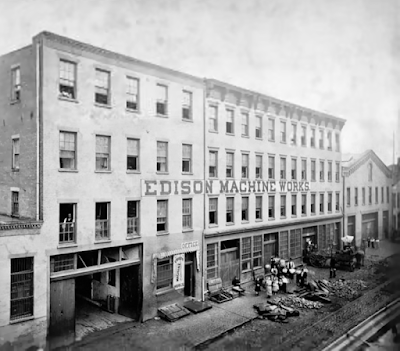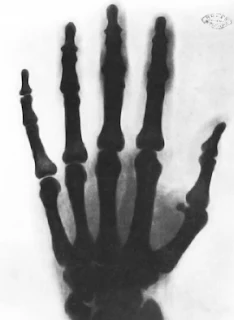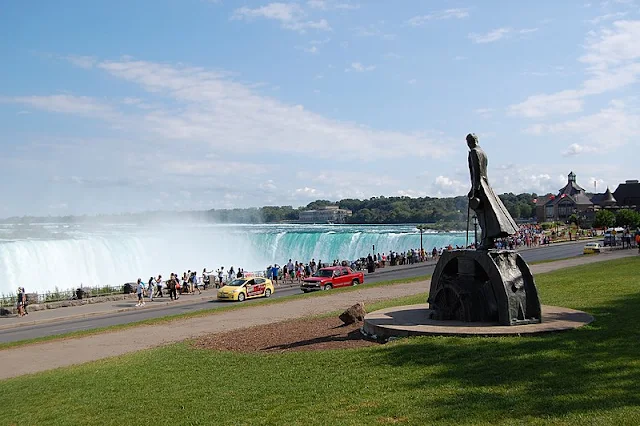Nikola Tesla’s AC dynamo-electric machine (AC electric generator) in an 1888 U.S. Patent 390,721
Tesla’s A.C. induction motor is widely used throughout the world in industry and household appliances. It started the industrial revolution at the turn of the century. Electricity today is generated transmitted and converted to mechanical power by means of his inventions. Tesla’s greatest achievement is his polyphase alternating current system, which is today lighting the entire globe.
Tesla astonished the world by demonstrating the wonders of alternating current electricity at the World Columbian Exposition in Chicago in 1893. Alternating current became standard power in the 20th Century. This accomplishment changed the world. He designed the first hydroelectric powerplant in Niagara Falls in 1895, which was the final victory of alternating current. The achievement was covered widely in the world press, and Tesla was praised as a hero worldwide. King Nikola of Montenegro conferred upon him the Order of Danilo.
Tesla was a pioneer in many fields. The Tesla coil, which he invented in 1891, is widely used today in radio and television sets and other electronic equipment. That year also marked the date of Tesla’s United States citizenship. His alternating current induction motor is considered one of the ten greatest discoveries of all time. Among his discoveries are the fluorescent light, laser beam, wireless communications, wireless transmission of electrical energy, remote control, robotics, Tesla’s turbines and vertical take off aircraft. Tesla is the father of the radio and the modern electrical transmissions systems. He registered over 700 patents worldwide. His vision included exploration of solar energy and the power of the sea. He foresaw interplanetary communications and satellites.
The Century Magazine published Tesla’s principles of telegraphy without wires, popularizing scientific lectures given before Franklin Institute in February 1893. The Electrical Review in 1896 published X-rays of a man, made by Tesla, with X-ray tubes of his own design. They appeared at the same time as when Roentgen announced his discovery of X-rays. Tesla never attempted to proclaim priority. Roentgen congratulated Tesla on his sophisticated X-ray pictures, and Tesla even wrote Roentgen’s name on one of his films. He experimented with shadowgraphs similar to those that later were to be used by Wilhelm Rontgen when he discovered X-rays in 1895. Tesla’s countless experiments included work on a carbon button lamp, on the power of electrical resonance, and on various types of lightning. Tesla invented the special vacuum tube which emitted light to be used in photography.
X-ray Tesla took of his hand
The breadth of his inventions is demonstrated by his patents for a bladeless steam turbine based on a spiral flow principle. Tesla also patented a pump design to operate at extremely high temperature.
Tesla’s bladeless turbine design
Nikola Tesla patented the basic system of radio in 1896. His published schematic diagrams describing all the basic elements of the radio transmitter which was later used by Marconi.
In 1896 Tesla constructed an instrument to receive radio waves. He experimented with this device and transmitted radio waves from his laboratory on South 5th Avenue to the Gerlach Hotel at 27th Street in Manhattan. The device had a magnet which gave off intense magnetic fields up to 20,000 lines per centimeter. The radio device clearly establishes his priority in the discovery of radio.
The shipboard quench-spark transmitter produced by the Lowenstein Radio Company and licensed under Nikola Tesla Company patents, was installed on the U.S. Naval vessels prior to World War I.
In December 1901, Marconi established wireless communication between Britain and the Newfoundland, Canada, earning him the Nobel prize in 1909. But much of Marconi’s work was not original. In 1864, James Maxwell theorized electromagnetic waves. In 1887, Heinrich Hertz proved Maxwell’s theories. Later, Sir Oliver Logde extended the Hertz prototype system. The Brandley coherer increased the distance messages could be transmitted. The coherer was perfected by Marconi.
However, the heart of radio transmission is based upon four tuned circuits for transmitting and receiving. It is Tesla’s original concept demonstrated in his famous lecture at the Franklin Institute in Philadelphia in 1893. The four circuits, used in two pairs, are still a fundamental part of all radio and television equipment.
The United States Supreme Court, in 1943 held Marconi’s most important patent invalid, recognizing Tesla’s more significant contribution as the inventor of radio technology.
Tesla built an experimental station in Colorado Springs, Colorado in 1899, to experiment with high voltage, high frequency electricity and other phenomena.
Tesla’s Colorado Springs laboratory
When the Colorado Springs Tesla Coil magnifying transmitter was energized, it created sparks 30 feet long. From the outside antenna, these sparks could be seen from a distance of ten miles. From this laboratory, Tesla generated and sent out wireless waves which mediated energy, without wires for miles.
In Colorado Springs, where he stayed from May 1899 until 1900, Tesla made what he regarded as his most important discovery– terrestrial stationary waves. By this discovery he proved that the Earth could be used as a conductor and would be as responsive as a tuning fork to electrical vibrations of a certain frequency. He also lighted 200 lamps without wires from a distance of 25 miles (40 kilometers) and created man-made lightning. At one time he was certain he had received signals from another planet in his Colorado laboratory, a claim that was met with disbelief in some scientific journals.
Nikola Tesla sitting in his Colorado Springs laboratory next to his huge “magnifying transmitter” Tesla coil which is producing 22 foot bolts of electricity
The old Waldorf Astoria was the residence of Nikola Tesla for many years. He lived there when he was at the height of financial and intellectual power. Tesla organized elaborate dinners, inviting famous people who later witnessed spectacular electrical experiments in his laboratory.
Financially supported by J. Pierpont Morgan, Tesla built the Wardenclyffe laboratory and its famous transmitting tower in Shoreham, Long Island between 1901 and 1905. This huge landmark was 187 feet high, capped by a 68-foot copper dome which housed the magnifying transmitter. It was planned to be the first broadcast system, transmitting both signals and power without wires to any point on the globe. The huge magnifying transmitter, discharging high frequency electricity, would turn the earth into a gigantic dynamo which would project its electricity in unlimited amounts anywhere in the world.
Tesla’s Wardenclyffe plant on Long Island in 1904. From this facility, Tesla hoped to demonstrate wireless transmission of electrical energy across the Atlantic.
Tesla’s concept of wireless electricity was used to power ocean liners, destroy warships, run industry and transportation and send communications instantaneously all over the globe. To stimulate the public’s imagination, Tesla suggested that this wireless power could even be used for interplanetary communication. If Tesla were confident to reach Mars, how much less difficult to reach Paris. Many newspapers and periodicals interviewed Tesla and described his new system for supplying wireless power to run all of the earth’s industry.
Because of a dispute between Morgan and Tesla as to the final use of the tower. Morgan withdrew his funds. The financier’s classic comment was, “If anyone can draw on the power, where do we put the meter?”
The erected, but incomplete tower was demolished in 1917 for wartime security reasons. The site where the Wardenclyffe tower stood still exists with its 100 feet deep foundation still intact. Tesla’s laboratory designed by Stanford White in 1901 is today still in good condition and is graced with a bicentennial plaque.
Tesla lectured to the scientific community on his inventions in New York, Philadelphia and St. Louis and before scientific organizations in both England and France in 1892. Tesla’s lectures and writings of the 1890s aroused wide admiration among contemporaries popularized his inventions and inspired untold numbers of younger men to enter the new field of radio and electrical science.
Nikola Tesla was one of the most celebrated personalities in the American press, in this century. According to Life Magazine’s special issue of September, 1997, Tesla is among the 100 most famous people of the last 1,000 years. He is one of the great men who divert the stream of human history. Tesla’s celebrity was in its height at the turn of the century. His discoveries, inventions and vision had widespread acceptance by the public, the scientific community and American press. Tesla’s discoveries had extensive coverage in the scientific journals, the daily and weekly press as well as in the foremost literary and intellectual publications of the day. He was the Super Star.
Tesla wrote many autobiographical articles for the prominent journal Electrical Experimenter, collected in the book, My Inventions. Tesla was gifted with intense powers of visualization and exceptional memory from early youth on. He was able to fully construct, develop and perfect his inventions completely in his mind before committing them to paper.
According to Hugo Gernsback, Tesla was possessed of a striking physical appearance over six feet tall with deep set eyes and a stately manner. His impressions of Tesla, were of a man endowed with remarkable physical and mental freshness, ready to surprise the world with more and more inventions as he grew older. A lifelong bachelor he led a somewhat isolated existence, devoting his full energies to science.
In 1894, he was given honorary doctoral degrees by Columbia and Yale University and the Elliot Cresson medal by the Franklin Institute. In 1934, the city of Philadelphia awarded him the John Scott medal for his polyphase power system. He was an honorary member of the National Electric Light Association and a fellow of the American Association for the Advancement of Science. On one occasion, he turned down an invitation from Kaiser Wilhelm II to come to Germany to demonstrate his experiments and to receive a high decoration.
In 1915, a New York Times article announced that Tesla and Edison were to share the Nobel Prize for physics. Oddly, neither man received the prize, the reason being unclear. It was rumored that Tesla refused the prize because he would not share with Edison, and because Marconi had already received his.
On his 75th birthday in 1931, the inventor appeared on the cover of Time Magazine. On this occasion, Tesla received congratulatory letters from more than 70 pioneers in science and engineering including Albert Einstein. These letters were mounted and presented to Tesla in the form of a testimonial volume.
Tesla on Time magazine commemorating his 75th birthday
Tesla died on January 7th, 1943 in the Hotel New Yorker, where he had lived for the last ten years of his life. Room 3327 on the 33rd floor is the two-room suites he occupied.
A state funeral was held at St. John the Divine Cathedral in New York City. Telegrams of condolence were received from many notables, including the first lady Eleanor Roosevelt and Vice President Wallace. Over 2000 people attended, including several Nobel Laureates. He was cremated in Ardsley on the Hudson, New York. His ashes were interned in a golden sphere, Tesla’s favorite shape, on permanent display at the Tesla Museum in Belgrade along with his death mask.
In his speech presenting Tesla with the Edison medal, Vice President Behrend of the Institute of Electrical Engineers eloquently expressed the following: “Were we to seize and eliminate from our industrial world the result of Mr. Tesla’s work, the wheels of industry would cease to turn, our electric cars and trains would stop, our towns would be dark and our mills would be idle and dead. His name marks an epoch in the advance of electrical science.” Mr. Behrend ended his speech with a paraphrase of Pope’s lines on Newton: “Nature and nature’s laws lay hid by night. God said ‘Let Tesla be’ and all was light.”


Nikola Tesla’s Awards and Recognition
In 1917, Tesla was awarded the Edison Medal, the most coveted electrical prize in the United States.
Nikola Tesla’s name has been honored with an International Unit of Magnetic Flux Density called “Tesla.”
The United States Postal Service honored Tesla with a commemorative stamp in 1983.
Tesla was inducted into the Inventor’s Hall of Fame in 1975.
The Nikola Tesla Award is one of the most distinguished honors presented by the Institute of Electrical Engineers. The award has been given annually since 1976.
The Nikola Tesla Statue is located on Goat Island to honor the man whose inventions were incorporated into the Niagara Falls Power Station in 1895. Tesla is known as the inventor of polyphase alternating current.
The Nikola Tesla Corner Sign, located at the intersection of 40th Street and 6th Avenue in Manhattan, is a constant reminder to all New Yorkers of the greatness of this genius.
Nikola Tesla Monument in Zagreb, Croatia
Nikola Tesla Corner in New York City
Nikola Tesla statue in Niagara Falls, Ontario
Nicola Tesla Museum in Belgrade, Serbia
Tesla sitting in front of a spiral coil used in his wireless power experiments at his East Houston St. laboratory
Source: https://www.teslasociety.com/biography.htm
https://en.wikipedia.org/wiki/Nikola_Tesla








































